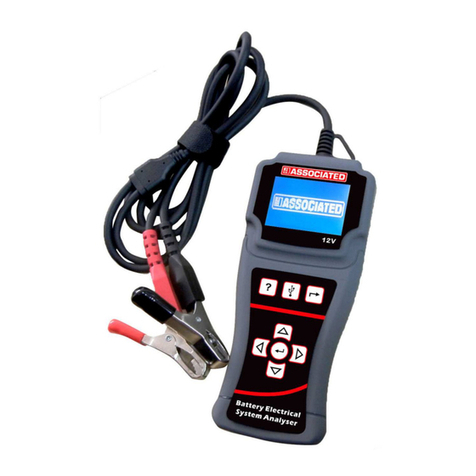
Model 12-1015 Users’ Manual Version 13.08
5043 Farlin Ave. 800-949-147 (US)
Table of Contents
1.0 Introduction----------------------------------------------------------------------------------------------
1.1 MODEL 12-1015 (Battery Electrical System Analyzer) ----------------------------------------------------3
1.2 Specifications-----------------------------------------------------------------------------------------------------------4
2.0 Safety Measures---------------------------------------------------------------------------------------
2.1 Safety Precautions-----------------------------------------------------------------------------------------------------5
2.2 Other Precautions------------------------------------------------------------------------------------------------------6
3.0 Working with Batteries-------------------------------------------------------------------------------
7.
4.0 The Battery Electrical System Analyzer------------------------------------------------------------
4.1 MODEL 12-1015 --------------------------------------------------------------------------------------------------------9
4.2 Key Functions-----------------------------------------------------------------------------------------------------------9
4.3 Functions of Individual Key---------------------------------------------------------------------------------------10
5.0 MODEL 12-1015 Setup ------------------------------------------------------------------------------
5.1 Printer Installation -------------------------------------------------------------------------------------------------- 11
5.2 Select Display Language------------------------------------------------------------------------------------------ 11
6.0 HELP Key----------------------------------------------------------------------------------------------
12
7.0 Battery Test--------------------------------------------------------------------------------------------
7.1 Start Testing -----------------------------------------------------------------------------------------------------------15
8.0 Battery Rating Charts--------------------------------------------------------------------------- -----
8.1 Japanese Industrial Standards (JIS#) Rating Chart-------------------------------------------------------27
8.2 DIN & EN Standards Rating Charts-----------------------------------------------------------------------------28
8.3 YUASA Battery Rating Chart -------------------------------------------------------------------------------------30
8.4 Rough CCA Guide----------------------------------------------------------------------------------------------------31
9.0 Grounding Test ----------------------------------------------------------------------------------------
9.1 Start Testing------------------------------------------------------------------------------------------------------------31
10.0 Starter Test ---------------------------------------------------------------------------------------------
10.1 Begin Testing----------------------------------------------------------------------------------------------------------37
11.0 Alternator Test---------------------------------------------------------------------------------------
11.1 Start Testing------------------------------------------------------------------------------------------------------------41
No load testing at 3,000 RPM-------------------------------------------------------------------------------------41
Testing with load at 2,000 RPM----------------------------------------------------------------------------------44
12.0 Printing and Viewing Test Results-------------------------------------------------------------
47
12.1 Printing the Last Test Results------------------------------------------------------------------------------------49
13.0 PC Link -------------------------------------------------------------------------------------------------
13.1 Installing Driver-------------------------------------------------------------------------------------------------------50
13.2 Printing Results from Normal Printer-------------------------------------------------------------------------54
13.3 Saving results---------------------------------------------------------------------------------------------------------54
14.0 Warranty Information--------------------------------------------------------------------------------
14.1 Limited Warranty-----------------------------------------------------------------------------------------------------55
14.2 Limitations of Warranty--------------------------------------------------------------------------------------------56





























